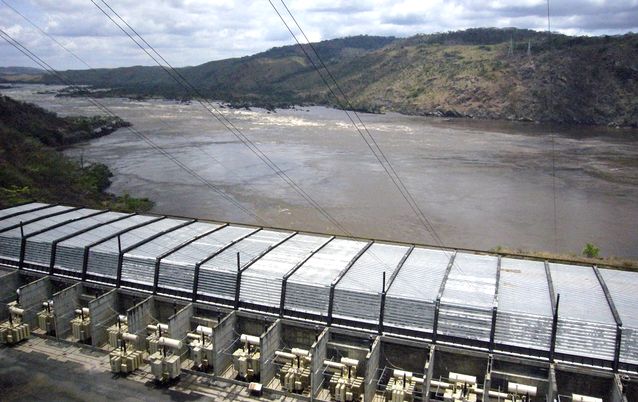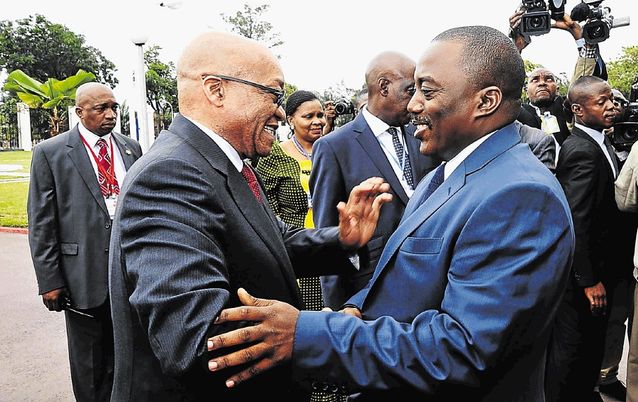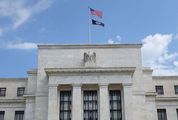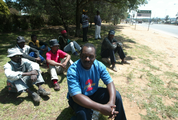THE Grand Inga dam complex in the Democratic Republic of Congo went another step closer to "zombie" status after the October construction start date, announced by the Congolese government at the signing in 2013 of a treaty with SA to develop the hydropower scheme, came and went without a sod being turned.
Politics and finance seem to be the reasons for the bulldozers’ no-show at the site on the Congo River.
Versions of the power complex have been on the drawing boards for close to a century. In 1920, the Congo River’s Inga rapids were "discovered" by a US geological survey team, which reported that "the Congo basin in its entirety possesses more than one-fourth of the world’s potential water power".
...
The team saw nearly 15km of white water descending about 100m — a source of almost unimaginable reserves of stored energy in the 43-million litres of water rushing by every second. A power station was quickly envisaged.
Sadly, apart from a few small installations, the river’s potential has never been realised. It is unlikely that it ever will be. It is too expensive, too risky, big dams are rapidly going out of fashion and other renewable and cheaper energy sources are finding more favour.
Two modest schemes were installed at Inga — a 351MW plant commissioned in 1972 and one of 1,424MW in 1982 — but they capture only a tiny fraction of the Congo River’s latent power and crank out less than 40% of the energy they should.
Both plants are victims of slipshod maintenance and chronic mismanagement, and there is little sign of the spending of billions of dollars from the World Bank meant for an upgrade in 2003.
Some effort has been put into getting the third phase under way — the 4,800MW Inga 3 scheme. Investors sat on the fence as the cost estimates ticked up — currently about $14bn with transmission infrastructure and finance costs.
New hope flared in Kinshasa when, in 2013, President Jacob Zuma and Congolese President Joseph Kabila signed a treaty that pledged co-operation in constructing the 40,000MW Grand Inga complex, starting with Inga 3 as a concrete step towards an eventual seven-dam hydropower behemoth.
The agreement bound SA to purchasing 2,500MW of Inga 3’s proposed 4,800MW output. Work was to start on October 15 last year.
All efforts to obtain explanations from the Presidency, the Department of International Relations and Co-operation, the Treasury and the Department of Energy were shunted off or ignored.
...
THE questions posed included: why did construction not begin on October 15? When will a developer for Inga 3 be selected? SA was obliged to pay a $10m deposit; has it been paid and, if so, will it be refunded if the project is stillborn? Have all the environmental issues been satisfied? Is the treaty a bankable document, as a power purchase agreement would be?
Congolese Water and Energy Minister Bruno Kapandji Kalala maintains that Grand Inga is on an unstoppable course, now that it is backed by SA.
"Grand Inga will provide more than half of the continent with renewable energy at a low price," he says. "Inga is a factor for integration, at both a regional and international level."
Responsibility for the southward transmission of Inga 3’s electricity will be split between SA and Congo, with the Congolese delivering the power to its border with Zambia and SA taking it from there. Eskom is investigating having the Inga power hitchhike on the Southern Africa Power Pool transmission lines to the South African grid.
While the governments of SA and Congo, remain mum on the construction start date, non-governmental organisations have been speculating on the reasons for the delay.
"The Congo River has been called a place where dreams go to die," says Peter Bosshard, the policy director of International Rivers. "But zombie dams apparently find it a source of eternal life: Inga 3, the third in line after the troubled Inga 1 and 2 dams, has been a twinkle in some demon’s eye since the 1920s.
"Its energy, however, would go almost exclusively for industry and export — not to the 90% of Congo’s 71-million citizens who have no access to electricity.
"The project will add to the Congo’s national debt burden and promote corruption, allowing powerful companies — yet again — to cheaply exploit and export Africa’s vast natural resources. Power-hungry SA keeps reviving this one."
According to International Rivers, a four-year upgrade of Inga 1 and 2 started in 2003 with a budget of $200m. About $1.2bn has been spent and the work is not done.
THE World Bank has been a patient contributor of billions of dollars pumped into the Inga scheme in seemingly endless feasibility studies — it spent $73m on a study for the Inga 3 Basse Chute and Mid-size Hydropower Development Technical Assistance Project.
The International Finance Corporation (IFC), a World Bank member, now seems to be taking a deeper interest in Inga.
...
THE African Development Bank, which has been involved in the project since 2009, is financing base studies and consultants, and has been joined by the French Development Agency, the European Investment Bank and the Development Bank of Southern Africa.
"The question of financing is a major issue in the selection process (of the developers)," says Hela Cheikhrouhou, director for energy, environment and climate change at the African Development Bank. "Public-private partnership financing solutions will be vital for the success of the project."
A spokesman for the World Bank agrees that the level of investment required for Inga 3 "is so high that neither the public sector nor the private sector alone could bear the full cost of development.
"All World Bank Group institutions share the same development mission. The IFC is focused on the private sector for development, and can play a role in structuring the private financing portion, providing capital to project sponsors and catalysing funding from other private financiers.
"Inga 3 Basse Chute will help improve electricity supply for 7-million people in Kinshasa, foster economic growth, and allow Congo to export power to other energy-deficient countries.
"The construction costs of Inga 3 Basse Chute development and associated transmission lines are estimated at $11bn."
With a projected cost of $80bn-$100bn, the private sector and finance institutions are baulking at the project, made far less attractive by its location in corruption-riddled and war-torn Congo.
So far, SA’s treaty appears to be Inga’s only support of any significance. Congo’s government says three consortia are competing for the project build: Sinohydro and Three Gorges Corporation from China, operator of the world’s largest dam; Actividades de Construcción y Servicios, Eurofinsa and AEE from Spain; and the SNC-Daewoo-Posco Lavalin consortium from South Korea and Canada.
Congolese Foreign Affairs Minister Raymond Tshibanda remains optimistic and enthusiastic, but urges careful and thoughtful progress: "It’s critical not to move fast, but to ensure that every step you take is on a solid ground.
"We have to mobilise financing and we are talking to the governments of China and SA and from now on, things are going to take another pace."
Ali Mbuyi Tshimpanga, director of the Inga 1 and 2 hydropower stations, is philosophical: "The problem is that, with a public-private partnership, you patch up only the part of the grid that interests the private financiers. It’s of almost no benefit to the community."
-

An aerial view of the semi-functional Inga dam on the Congo River, taken in 2006. The existing Inga 1 and 2 hydropower schemes operate at less than 40% of capacity Picture: REUTERS/MARLENE RABAUD
-

President Jacob Zuma greets DRC President Joseph Kabila in Kinshasa last year. The two presidents signed a pact in 2013 to develop the Grand Inga scheme, but the construction start date has come and gone with no action. Picture: SIYABULELA DUDA
THE Grand Inga dam complex in the Democratic Republic of Congo went another step closer to "zombie" status after the October construction start date, announced by the Congolese government at the signing in 2013 of a treaty with SA to develop the hydropower scheme, came and went without a sod being turned.
Politics and finance seem to be the reasons for the bulldozers’ no-show at the site on the Congo River.
Versions of the power complex have been on the drawing boards for close to a century. In 1920, the Congo River’s Inga rapids were "discovered" by a US geological survey team, which reported that "the Congo basin in its entirety possesses more than one-fourth of the world’s potential water power".
...
The team saw nearly 15km of white water descending about 100m — a source of almost unimaginable reserves of stored energy in the 43-million litres of water rushing by every second. A power station was quickly envisaged.
Sadly, apart from a few small installations, the river’s potential has never been realised. It is unlikely that it ever will be. It is too expensive, too risky, big dams are rapidly going out of fashion and other renewable and cheaper energy sources are finding more favour.
Two modest schemes were installed at Inga — a 351MW plant commissioned in 1972 and one of 1,424MW in 1982 — but they capture only a tiny fraction of the Congo River’s latent power and crank out less than 40% of the energy they should.
Both plants are victims of slipshod maintenance and chronic mismanagement, and there is little sign of the spending of billions of dollars from the World Bank meant for an upgrade in 2003.
Some effort has been put into getting the third phase under way — the 4,800MW Inga 3 scheme. Investors sat on the fence as the cost estimates ticked up — currently about $14bn with transmission infrastructure and finance costs.
New hope flared in Kinshasa when, in 2013, President Jacob Zuma and Congolese President Joseph Kabila signed a treaty that pledged co-operation in constructing the 40,000MW Grand Inga complex, starting with Inga 3 as a concrete step towards an eventual seven-dam hydropower behemoth.
The agreement bound SA to purchasing 2,500MW of Inga 3’s proposed 4,800MW output. Work was to start on October 15 last year.
All efforts to obtain explanations from the Presidency, the Department of International Relations and Co-operation, the Treasury and the Department of Energy were shunted off or ignored.
...
THE questions posed included: why did construction not begin on October 15? When will a developer for Inga 3 be selected? SA was obliged to pay a $10m deposit; has it been paid and, if so, will it be refunded if the project is stillborn? Have all the environmental issues been satisfied? Is the treaty a bankable document, as a power purchase agreement would be?
Congolese Water and Energy Minister Bruno Kapandji Kalala maintains that Grand Inga is on an unstoppable course, now that it is backed by SA.
"Grand Inga will provide more than half of the continent with renewable energy at a low price," he says. "Inga is a factor for integration, at both a regional and international level."
Responsibility for the southward transmission of Inga 3’s electricity will be split between SA and Congo, with the Congolese delivering the power to its border with Zambia and SA taking it from there. Eskom is investigating having the Inga power hitchhike on the Southern Africa Power Pool transmission lines to the South African grid.
While the governments of SA and Congo, remain mum on the construction start date, non-governmental organisations have been speculating on the reasons for the delay.
"The Congo River has been called a place where dreams go to die," says Peter Bosshard, the policy director of International Rivers. "But zombie dams apparently find it a source of eternal life: Inga 3, the third in line after the troubled Inga 1 and 2 dams, has been a twinkle in some demon’s eye since the 1920s.
"Its energy, however, would go almost exclusively for industry and export — not to the 90% of Congo’s 71-million citizens who have no access to electricity.
"The project will add to the Congo’s national debt burden and promote corruption, allowing powerful companies — yet again — to cheaply exploit and export Africa’s vast natural resources. Power-hungry SA keeps reviving this one."
According to International Rivers, a four-year upgrade of Inga 1 and 2 started in 2003 with a budget of $200m. About $1.2bn has been spent and the work is not done.
THE World Bank has been a patient contributor of billions of dollars pumped into the Inga scheme in seemingly endless feasibility studies — it spent $73m on a study for the Inga 3 Basse Chute and Mid-size Hydropower Development Technical Assistance Project.
The International Finance Corporation (IFC), a World Bank member, now seems to be taking a deeper interest in Inga.
...
THE African Development Bank, which has been involved in the project since 2009, is financing base studies and consultants, and has been joined by the French Development Agency, the European Investment Bank and the Development Bank of Southern Africa.
"The question of financing is a major issue in the selection process (of the developers)," says Hela Cheikhrouhou, director for energy, environment and climate change at the African Development Bank. "Public-private partnership financing solutions will be vital for the success of the project."
A spokesman for the World Bank agrees that the level of investment required for Inga 3 "is so high that neither the public sector nor the private sector alone could bear the full cost of development.
"All World Bank Group institutions share the same development mission. The IFC is focused on the private sector for development, and can play a role in structuring the private financing portion, providing capital to project sponsors and catalysing funding from other private financiers.
"Inga 3 Basse Chute will help improve electricity supply for 7-million people in Kinshasa, foster economic growth, and allow Congo to export power to other energy-deficient countries.
"The construction costs of Inga 3 Basse Chute development and associated transmission lines are estimated at $11bn."
With a projected cost of $80bn-$100bn, the private sector and finance institutions are baulking at the project, made far less attractive by its location in corruption-riddled and war-torn Congo.
So far, SA’s treaty appears to be Inga’s only support of any significance. Congo’s government says three consortia are competing for the project build: Sinohydro and Three Gorges Corporation from China, operator of the world’s largest dam; Actividades de Construcción y Servicios, Eurofinsa and AEE from Spain; and the SNC-Daewoo-Posco Lavalin consortium from South Korea and Canada.
Congolese Foreign Affairs Minister Raymond Tshibanda remains optimistic and enthusiastic, but urges careful and thoughtful progress: "It’s critical not to move fast, but to ensure that every step you take is on a solid ground.
"We have to mobilise financing and we are talking to the governments of China and SA and from now on, things are going to take another pace."
Ali Mbuyi Tshimpanga, director of the Inga 1 and 2 hydropower stations, is philosophical: "The problem is that, with a public-private partnership, you patch up only the part of the grid that interests the private financiers. It’s of almost no benefit to the community."























Change: 0.55%
Change: 0.57%
Change: 0.54%
Change: 0.13%
Change: 2.31%
Data supplied by Profile Data
Change: 1.16%
Change: 0.64%
Change: 0.55%
Change: 0.00%
Change: 1.05%
Data supplied by Profile Data
Change: 0.12%
Change: -0.13%
Change: 0.39%
Change: 1.02%
Change: 0.11%
Data supplied by Profile Data
Change: 0.38%
Change: 0.32%
Change: 0.27%
Change: 0.19%
Change: 1.11%
Data supplied by Profile Data